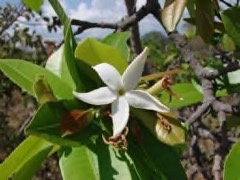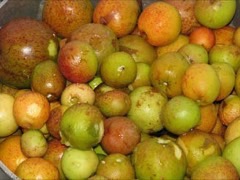 |
|
João Medeiros wikimedia.org |
 |
| Isabela Lustz Portela Lima wikimedia.org |
Translate this page:
Summary
Hancornia is native to South America (Brazil, Peru, Bolivia, Paraguay). It contains only one known species, Hancornia speciosa, commonly called mangabeira, which produces fruits known as mangabas.
Physical Characteristics

 Hancornia speciosa is a deciduous Tree growing to 7 m (23ft) by 5 m (16ft) at a slow rate.
Hancornia speciosa is a deciduous Tree growing to 7 m (23ft) by 5 m (16ft) at a slow rate.
See above for USDA hardiness. It is hardy to UK zone 10.
Suitable for: light (sandy) and medium (loamy) soils, prefers well-drained soil and can grow in nutritionally poor soil. Suitable pH: mildly acid, neutral and basic (mildly alkaline) soils. It cannot grow in the shade. It prefers moist soil and can tolerate drought.
UK Hardiness Map
US Hardiness Map
Synonyms
Hancornia gardneri Muell.Arg.; Hancornia lundii A DC.; Hancornia maximiliana A DC.; Hancornia pubescens Muell.Arg.; Ribeirea sorbilis Arr.Cam.; Echites glauca Roem. & Schult.;.
Plant Habitats
Edible Uses
Edible Parts: Fruit
Edible Uses:
Edible Portion - raw or cooked[301 , 416 ]. The fruit needs to be very ripe and soft (fallen to the ground) to be free of any latex or bitterness[416 ]. Fully ripe fruits have a delicious, succulent, viscous, sweet, aromatic pulp[416 ]. A pleasant subacid flavour[301 , 335 ]. The fruit can also be made into a juice, sherbet, preserves etc[301 ]. It is much esteemed as a marmalade in parts of Brazil[46 , 301 ]. The fruit is 3 - 6cm in diameter[335 ].
References More on Edible Uses
Medicinal Uses
Plants For A Future can not take any responsibility for any adverse effects from the use of plants. Always seek advice from a professional before using a plant medicinally.
The plant is an excellent remedy for bilious complaints[460 ].
References More on Medicinal Uses
The Bookshop: Edible Plant Books
Our Latest books on Perennial Plants For Food Forests and Permaculture Gardens in paperback or digital formats.

Edible Tropical Plants
Food Forest Plants for Hotter Conditions: 250+ Plants For Tropical Food Forests & Permaculture Gardens.
More

Edible Temperate Plants
Plants for Your Food Forest: 500 Plants for Temperate Food Forests & Permaculture Gardens.
More

More Books
PFAF have eight books available in paperback and digital formats. Browse the shop for more information.
Shop Now
Other Uses
The tree is a source of mangabeira rubber, which is of good quality and has in the past been exported from parts of Brazil[46 ]. The wood is light, spongy, soft and easy to work with. It has little durability, even when protected from the weather. It is only used for making boxes and for fuel[419 ]. Carbon Farming - Industrial Crop: hydrocarbon.
Special Uses
Carbon Farming
References More on Other Uses
Cultivation details
Industrial Crop: Hydrocarbon Management: Standard Regional Crop
Climate: tropical. Humidity: semi-arid to humid. A plant of the 'Caatinga' dry forest region of northeast Brazil. The climate is hot and dry, there are usually 6 to 11 months without rain each year. The mean annual rainfall varies from 250 - 1,000mm, and the mean annual temperature is from 24 - 26°c. Requires a sunny position to be at its best[419 ]. Grows best in a sandy soil, often growing in quite poor soils in the wild[335 , 419 ]. Established plants are drought tolerant[419 ]. Young plants grow slowly and are difficult to cultivate[416 ]. A very variable plant, a number of varieties have been described[416 ]. Plants grow slowly. Carbon Farming - Cultivation: regional crop. Management: standard.
Carbon Farming
-
Industrial Crop: Hydrocarbon
Materials, chemicals and energy include bioplastics, rubber, biomass products gasoline, jet fuel, diesel, butane, propane, biogas. Plants are usually resprouting plants and saps.
-
Management: Standard
Plants grow to their standard height. Harvest fruit, seeds, or other products. Non-Destructive management systems.
-
Regional Crop
These crops have been domesticated and cultivated regionally but have not been adopted elsewhere and are typically not traded globally, Examples in this broad category include perennial cottons and many nuts and staple fruits.
References Carbon Farming Information and Carbon Sequestration Information
Temperature Converter
Type a value in the Celsius field to convert the value to Fahrenheit:
Fahrenheit:
The PFAF Bookshop
Plants For A Future have a number of books available in paperback and digital form. Book titles include Edible Plants, Edible Perennials, Edible Trees,Edible Shrubs, Woodland Gardening, and Temperate Food Forest Plants. Our new book is Food Forest Plants For Hotter Conditions (Tropical and Sub-Tropical).
Shop Now
Plant Propagation
Plants are grown from seed. The seeds from ripe fruit are removed and dried in the shade then planted. Seed - germinates easily[416 ]. It is best sown as soon as it is ripe and, since it does not transplant very well, is best sown in individual containers[419 ]. Germination rates are usually low, the seeds can be slow to sprout and also grow away slowly once they have sprouted[419 ].
Other Names
If available other names are mentioned here
Mangabeira, Mangabinha do norte, Manguba, Mangaba-da-restinga.
Native Range
SOUTHERN AMERICA: Brazil (Alagoas, Amazonas, Bahia, Ceará, Espírito Santo, Goiás, Maranhão, Mato Grosso, Mato Grosso do Sul, Minas Gerais, Paraíba, Paraná, Pernambuco, Piauí, Rio de Janeiro, Sergipe, Amapá), Bolivia (El Beni, Santa Cruz), Peru, Paraguay (Amambay, Canindeyú, Concepción, San Pedro)
Weed Potential
Right plant wrong place. We are currently updating this section.
Please note that a plant may be invasive in one area but may not in your area so it's worth checking.
None Known
Conservation Status
IUCN Red List of Threatened Plants Status : This taxon has not yet been assessed

Growth: S = slow M = medium F = fast. Soil: L = light (sandy) M = medium H = heavy (clay). pH: A = acid N = neutral B = basic (alkaline). Shade: F = full shade S = semi-shade N = no shade. Moisture: D = dry M = Moist We = wet Wa = water.
Now available:
Food Forest Plants for Mediterranean Conditions
350+ Perennial Plants For Mediterranean and Drier Food Forests and Permaculture Gardens.
[Paperback and eBook]
This is the third in Plants For A Future's series of plant guides for food forests tailored to
specific climate zones. Following volumes on temperate and tropical ecosystems, this book focuses
on species suited to Mediterranean conditions—regions with hot, dry summers and cool, wet winters,
often facing the added challenge of climate change.
Read More
Expert comment
Author
Gomes
Botanical References
Links / References
For a list of references used on this page please go here
A special thanks to Ken Fern for some of the information used on this page.
Readers comment
| Add a comment |
|
If you have important information about this plant that may help other users please add a comment or link below. Only comments or links that are felt to be directly relevant to a plant will be included. If you think a comment/link or information contained on this page is inaccurate or misleading we would welcome your feedback at [email protected]. If you have questions about a plant please use the Forum on this website as we do not have the resources to answer questions ourselves.
* Please note: the comments by website users are not necessarily those held by PFAF and may give misleading or inaccurate information.
To leave a comment please Register or login here All comments need to be approved so will not appear immediately.
|
Subject : Hancornia speciosa
|
|
|
|